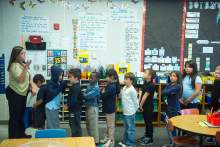This is an archived article that was published on sltrib.com in 2016, and information in the article may be outdated. It is provided only for personal research purposes and may not be reprinted.
Minority enrollment in Utah's public schools increased by more than 5,000 students in 2016, according to demographic data released Thursday by the Utah Board of Education.
But compared with a total student body of more than 644,000 — and 483,000 white students — the increase translates to a statistical rounding error.
This year, 24.99 percent of public school students belong to a racial minority group, compared with 24.59 percent last year.
And an influx of 1,390 low-income students had a similar effect, shifting that group ratio in Utah from 35 percent in 2015 to 34.7 percent this year.
"We've added students but we haven't really changed the percentage demographics," said Mark Peterson, spokesman for the office of the Utah Board of Education.
Total enrollment for 2016 was first reported earlier this week, showing 1.67 percent growth statewide, or 10,580 additional students, and a 5.9 percent growth rate among charter schools, down from 8.9 percent last year.
In recent years, school diversity levels have increased while poverty has decreased.
But an overall decrease in migration and births means sluggish changes in the composition of Utah's children, according to Pam Perlich, director of demographic research for the University of Utah's Kem C. Gardner Policy Institute.
"Migration came almost completely to a stop in 2008," she said, "and is only slowly rebuilding."
Perlich said Utah's birth rates have been in decline for several years, but that is traditionally offset by families entering the state with young children or having children after moving to the state.
But recently, she said, the decline in birth rates has led to a drop in the total number of births, leading to successively smaller kindergarten populations each year.
"You begin in 2008 and every year the number of births has gone down," she said.
The enrollment data also show that 73,171 students, or 11.4 percent, are receiving special education services. And 39,680 students, or 6.2 percent, are English language learners.
"Meeting the educational needs of a growing student population will continue to be a challenge for Utah's public schools," state Superintendent Sydnee Dickson said in a prepared statement.
bwood@sltrib.com Twitter: @bjaminwood



